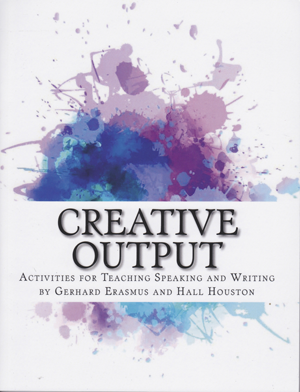Creative Output: Activities for Teaching Speaking and Writing
Creative Output: Activities for Teaching Speaking and Writing
by Gerhard Erasmus and Hall Houston Erasmus and Houston 2017 978-1-537-12828-3

How do I keep my lessons interesting and fun over the long haul? This is a question most of us have had to ask at some point in our teaching careers. Students demand that their lessons should be both fun and interesting, perhaps more than ever, and it is part of the unspoken contract between the students and the teacher that they should be so. No matter how many training courses we have been on, and how many years of experience we have, the pressure to vary what we do in our classrooms is constant – whether it is that special observed lesson, the need to keep our students engaged over months of instruction, or simply to prevent us, as teachers, from getting bored and frustrated with having to teach the same material all over again. Variety and creative resourceful ideas for activities is where Creative Output meets this need.
The self-published book is divided into two main subsections. In Part A, Erasmus and Houston briefly discuss the theory behind their title – namely, output hypothesis – stating that producing language, ie speaking and writing, is a vital part of learning a second language. From this foundation, conditions that need to be met for output activities to be effective are laid down.
The authors state their goal to be that everything said in the book ‘is questioned and that different readers each get something different out of [it]’. They clearly aim to provide their readers with a springboard for thought and discussion. They demonstrate their awareness that every teacher is a materials developer to some extent, but that, generally, little guidance is provided by training courses and books as to how to approach the task of supplementing the coursebook with engaging and true-to-life activities. In light of this, two of the most useful sections in the first part of the book are the checklists of procedures for successful speaking and writing activities.
The practical Part B contains easy-to-navigate sections on speaking and writing activities (separate and integrated), moving from input to output, book-based activities and those tailored to young learners.
The book concludes with a brief list of language functions with contexts in which they appear, as well as a list of resources on teaching speaking and writing, and the output hypothesis.
Some of the highlights of the book are:
- The open-ended nature of the activities, which leaves ample space for adaptation.
- The step-by-step procedures given for each activity.
- The creative variations on familiar coursebook tasks which are offered.
- The layout, which provides space to customise each activity by adding notes and comments.
- In the real world, individual language skills are rarely used in isolation. The authors skilfully address the need for integrated practice of productive skills.
There are some things that I think could be improved. For example, many of the activities depend on the students being able to contribute resourceful ideas, which in my experience is often not the case. I also feel that some activities would benefit from a clear rationale and clarification about how the success of the activity will be measured. In addition, many of them seem to be tailored to students whose needs consist of forming and discussing opinions. This might be a valid approach in certain contexts, but it would be good to see other language functions covered in the book. The activities would also benefit from recommendations of level and indications of approximate timing.
There is, as yet, no conclusive evidence as to the exact nature of second language acquisition, and no one has yet been able to determine the most effective language teaching method. However, I believe that this book would make a highly pragmatic and useful contribution to every teacher’s toolbox of activities.
Paulina Melichova
Dundee, Scotland
Comments
Write a Comment
Comment Submitted